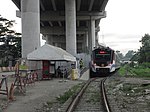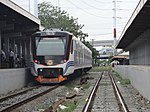
A diesel multiple unit or DMU is a multiple-unit train powered by on-board diesel engines. A DMU requires no separate locomotive, as the engines are incorporated into one or more of the carriages. Diesel-powered single-unit railcars are also generally classed as DMUs. Diesel-powered units may be further classified by their transmission type: diesel–mechanical DMMU, diesel–hydraulic DHMU, or diesel–electric DEMU.
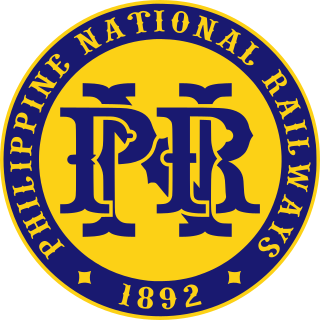
The Philippine National Railways (PNR) is a state-owned railway company in the Philippines which operates one commuter rail service between Metro Manila and Laguna, and local services between Sipocot, Naga and Legazpi in the Bicol Region. It is an attached agency of the Department of Transportation.

The 203 series (203系) is an electric multiple unit (EMU) train type operated in Japan between 1982 and 2011 by Japanese National Railways (JNR) and later by East Japan Railway Company, and currently operated by KAI Commuter and Philippine National Railways.

KRL Commuterline, commonly known as Greater Jakarta Commuter rail, or KRL Jabodetabek is a commuter rail system for Greater Jakarta in Indonesia. It was previously known as KRL Jabodetabek. It is operated by KAI Commuter (KAIC/KCI), a subsidiary of the Indonesian national railway company PT Kereta Api Indonesia (KAI). The rail system uses rolling stock of rapid transit standard and operates at high frequency with a minimum headway. In 2019, the average number of KRL users per day reaches average of 1.04 million, with the record of the highest number of users served in a day being 1,154,080.
PT Industri Kereta Api (Persero), abbreviated as INKA, is an Indonesian state owned rolling stock manufacturer.

The PNR 900 class is a class of 21 GE Universal Series diesel–electric locomotives operated by the Philippine National Railways since 1973. The locomotives comes with three different types: U14CP (1973), U14C (1979), and U15C (1991). Initially used for long-distance express services throughout Luzon, they were relegated to hauling commuter trains within Metro Manila, a task previously done by PNR's diesel multiple units fleet. This was further exacerbated by the closure of the PNR South Main Line's intercity section in 2012 after an accident in Sariaya, Quezon.

The PNR 2500 class is a class of 43 GE U10B Diesel Electric Locomotives first introduced in 1965 with the delivery of the first 13 locomotives of the class. The locomotives were previously used for long haul services in the PNR North Main Line and the PNR South Main Line.

The PNR Hyundai Rotem DMU is a diesel multiple unit (DMU) train operated by the Philippine National Railways (PNR) since 2009.

The KiHa 52 is a Japanese diesel multiple unit (DMU) type formerly operated by Japanese National Railways (JNR); JR Group companies such as JR East, JR West, JR Shikoku & JR Kyushu; and later by the private railway operator Isumi Railway based in Chiba, Japan, by overseas operators such as Myanmar Railways in Myanmar, and the Philippine National Railways in the Philippines.

The PNR Metro Commuter Line was a commuter rail line operated by the Philippine National Railways. It was first inaugurated as the Metro Manila Commuter Service in 1970, and originally served the North Main Line and the South Main Lines, as well as the defunct Carmona and Guadalupe branch lines. Since then, it adopted several names such as Metrotrak and Metrotren, before adopting its present name in the late 2000s. The line was also nicknamed the Orange Line due to its designation in the 1970s.
The KiHa 59 series (キハ59系) is a diesel multiple unit train type operated by Japanese National Railways and then later operated by JR Hokkaido, JR West, and JR East between 1985 and 2010, and by the Philippine National Railways (PNR) on the Metro South Commuter and Isarog Express lines since 2012. It is a reconditioned diesel train remodeled from aging JNR-Era rolling stocks converted from KiHa 56, 28 & 58 units for conversion into chartered-type trains across Japan.

Commuter rails in Surabaya metropolitan area consists of separate commuter-type local train services operated by KAI Commuter in Surabaya, East Java, Indonesia, and its surrounding areas, such as Gresik, Mojokerto, Pasuruan, Sidoarjo and Lamongan with Commuter Line Supas, Commuter Line Jenggala, Commuter Line Sindro, and Commuter Line Blorasura trains, also Malang and Blitar with Commuter Line Dhoho, Commuter Line Penataran, and Commuter Line Tumapel

Prambanan Express Commuter Line or simply Prambanan Express, commonly abbreviated as Pramex and Prameks, is a commuter rail service that operates between Yogyakarta, Special Region of Yogyakarta and Kutoarjo, Purworejo Regency, Central Java in Indonesia. The service, which first operated in 1994, covers a distance of about 64 kilometers and operates using diesel multiple unit trains. It was previously serving Yogyakarta–Solo for 26 years before it was electrified in 2021.

The North–South Commuter Railway (NSCR), also known as the Clark–Calamba Railway, is a 147-kilometer (91-mile) urban rail transit system under construction in the island of Luzon in the Philippines. Running from New Clark City in Capas to Calamba, Laguna with 36 stations and four services, the railway is designed to improve connectivity within the Greater Manila Area, and it will be integrated with the railway network in the region.

The PNR South Main Line is one of the two trunk lines that form the Philippine National Railways' network in the island of Luzon, Philippines. It was opened in stages between 1916 and 1938 by the Manila Railroad. Services peaked in the 1940s until the late 1960s, when the system started to decline. Since 1988, it was the only functioning inter-city rail after its counterpart to the north, the North Main Line, was closed. The intercity section of the line in Laguna, Quezon and the Bicol Region was then closed and reopened repeatedly between 2004 and 2014 due to a combination of declining ridership and was closed since then. Currently, only a little more than half of line is operational PNR Metro Commuter Line between Tutuban station and Laguna, Inter-Provincial Commuter from San Pedro to Lucena and the Bicol Commuter regional rail service between Sipocot, Naga Camarines Sur and Legazpi Albay.

The PNR 8100 class is a diesel multiple unit (DMU) train operated by the Philippine National Railways (PNR) since 2020.
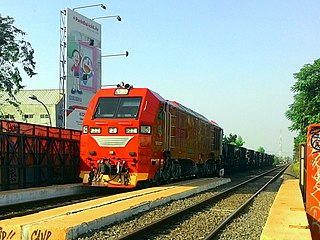
The INKA CC300, also known in the Philippines as the PNR 9000 Class, is a multipurpose Diesel-hydraulic locomotive owned by Directorate General of Railways and built by Indonesian state-owned rolling stock manufacturer PT INKA. Launched in 2013, it is the first mainline locomotive wholly produced by Indonesia and the first locomotive exported by Indonesia to another country, when the Philippine National Railways (PNR) received its first set of INKA CC300 locomotives in December 2020.

The PNR South Long Haul Project, also known as PNR Bicol is a proposed inter-city rail line in southern Luzon, Philippines. It is part of the larger Luzon Rail System, a network of long-distance standard-gauge lines being built by the Philippine National Railways throughout Luzon. It is one of the two lines that will reconstruct the historic PNR South Main Line, along with the electrified North–South Commuter Railway South section to Calamba, Laguna.
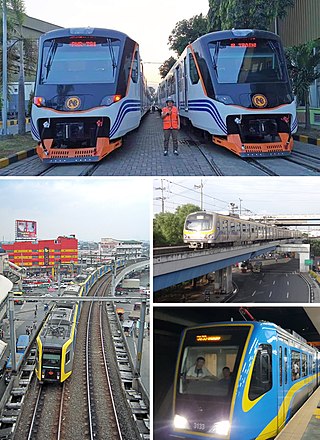
Rail transportation in the Greater Manila Area is a major part of the transportation system in Metro Manila and its surrounding areas. It consists of the Manila Light Rail Transit System, Manila Metro Rail Transit System, and the PNR Metro Commuter Line. The network makes up the majority of active railways in the country and bear the brunt of providing the metropolis with rail as a faster alternative mode of transport other than buses and jeepneys. However, these systems are currently insufficient for the rapidly expanding metropolis; to address this, new lines and line extensions are under construction, which will extend the system far out into neighboring regions.

The PNR 8300 class, also referred to as INKA coaches, is a class of locomotive-hauled passenger coaches operated by the Philippine National Railways since 2021.


